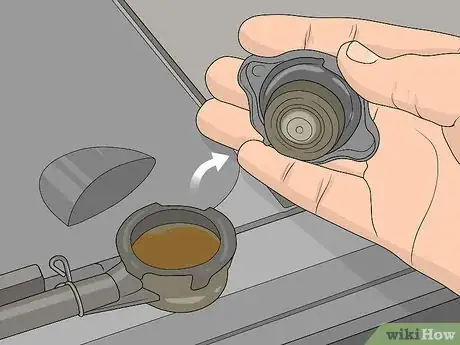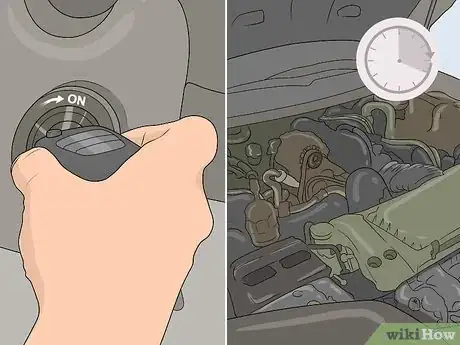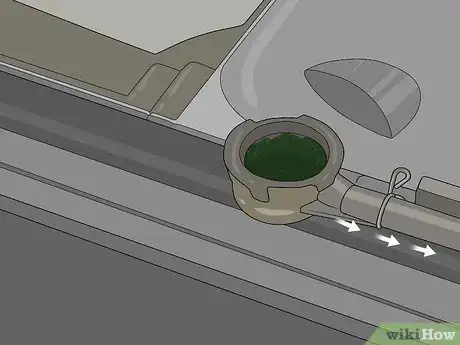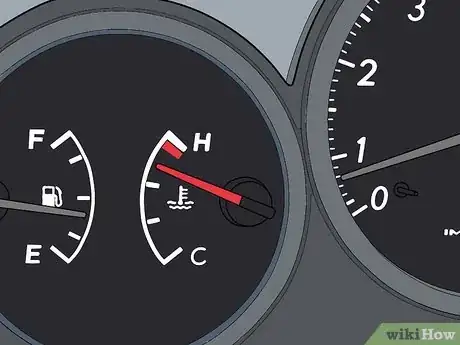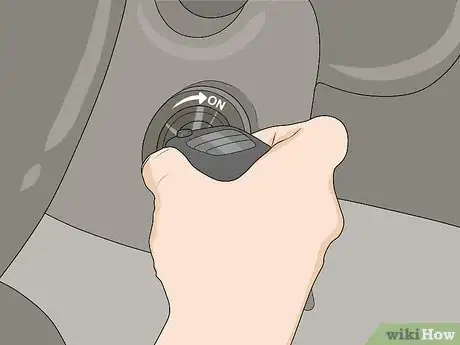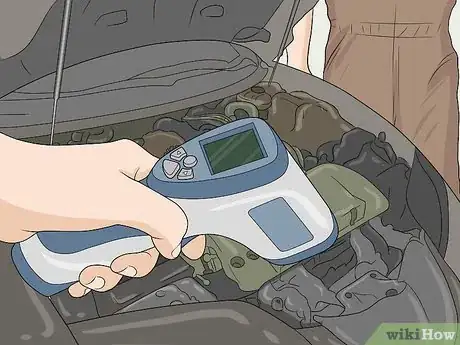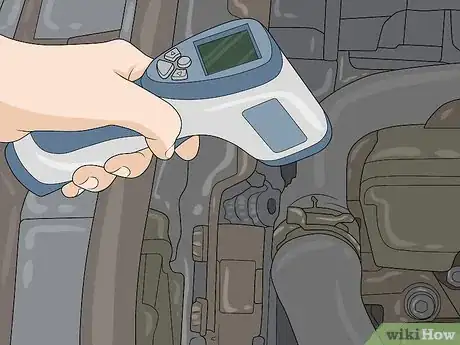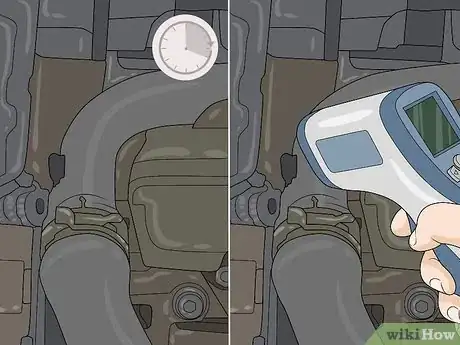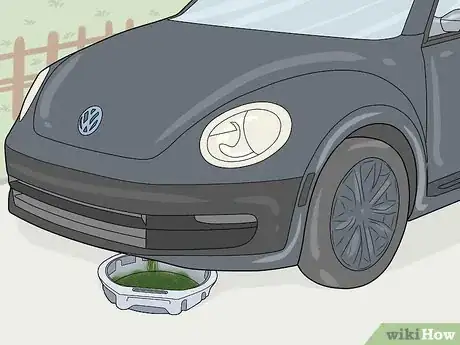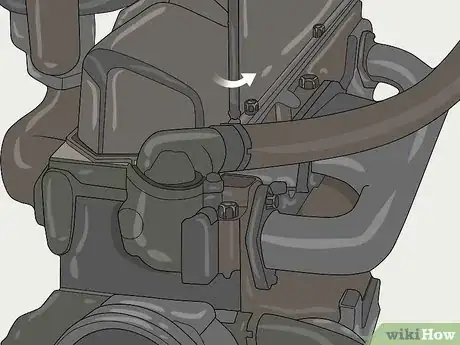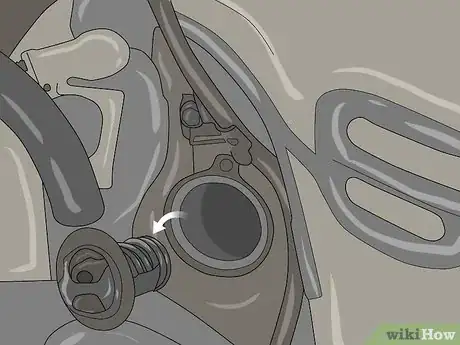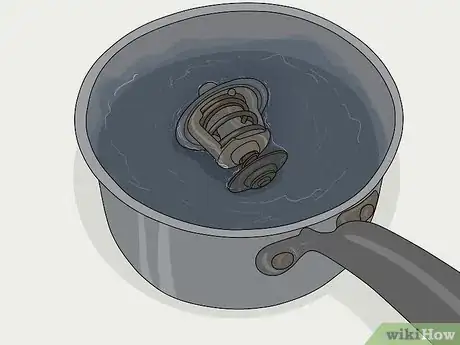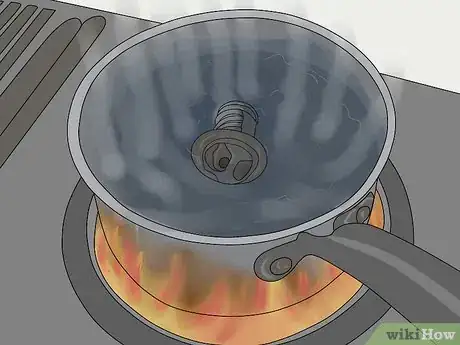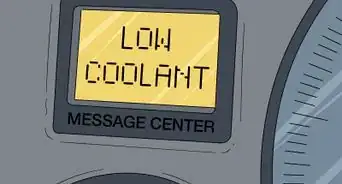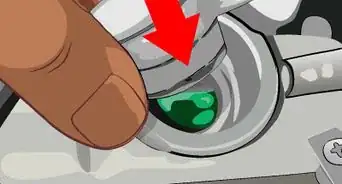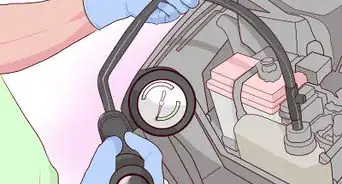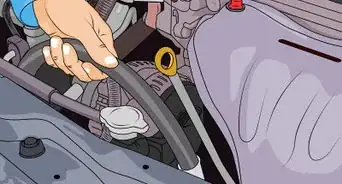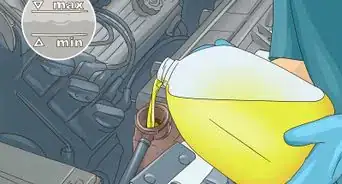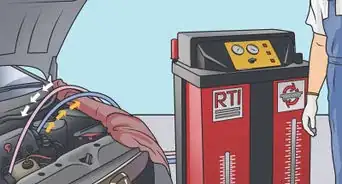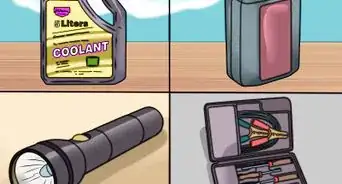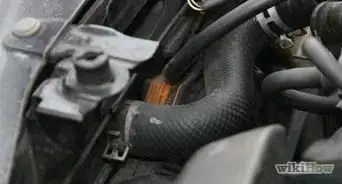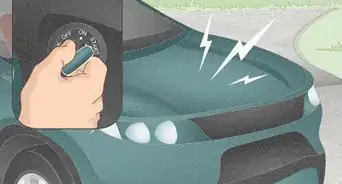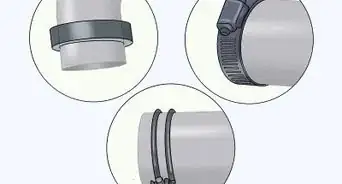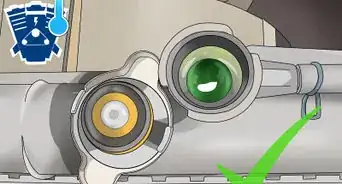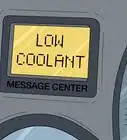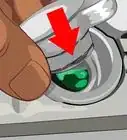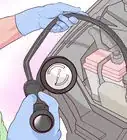This article was co-authored by Charlie Payne and by wikiHow staff writer, Hunter Rising. Charlie Payne is an Auto Repair Expert and the Owner & Operator of Perfect Reflections Auto Body. With over 21 years of experience, he specializes in auto restorations and collision repairs. Charlie is PPG and DuPont certified and earned a Bachelor's Degree from Liberty University.
There are 10 references cited in this article, which can be found at the bottom of the page.
wikiHow marks an article as reader-approved once it receives enough positive feedback. In this case, 100% of readers who voted found the article helpful, earning it our reader-approved status.
This article has been viewed 1,301,568 times.
Your vehicle’s thermostat opens to allow coolant to flow through the radiator and cool the engine down. However, if the thermostat gets stuck in the closed position, the coolant can’t flow through the radiator and can make your engine overheat. To quickly tell if your thermostat is stuck, watch the flow of coolant through your radiator. For a more accurate test, measure the temperatures of the engine and the hose leading to the radiators to see if they’re similar. If you want a way to check the thermostat directly, remove it from your vehicle and heat it in a pot of water to see if it opens.
Steps
Observing the Coolant Flow
-
1Take the cap off of your radiator. Open the hood of your vehicle and prop it up so it doesn’t fall back down during your test. Locate the radiator, which looks like a narrow silver or black box, and is at the front of your vehicle directly behind the grill. Look for the circular metal cap on the left or right side of the radiator and turn it counterclockwise to loosen it.[1]
- If you’ve driven recently, wait until the engine cools completely before starting. Otherwise, the test may be inaccurate.
- Don’t open the radiator cap immediately after running your vehicle since it could be extremely hot and cause burns.
-
2Start your engine and let it idle for 10-20 minutes. Leave your vehicle in park and turn it on so the engine starts. From a cold start, your vehicle’s thermostat will stay closed and you won’t notice any coolant flowing into your radiator. Leave the vehicle running for about 10-20 minutes so it can reach its optimal running temperature.[2]
- If you notice coolant flowing into the radiator right when you start your vehicle, then the thermostat is stuck in the open position.
- Don’t run your vehicle in an enclosed space since it will create harmful fumes.
Advertisement -
3Look into your radiator to check if coolant is flowing through it. After 10-20 minutes pass, keep your head at least 1–2 feet (30–61 cm) away and look down into the radiator where you removed the cap to check on the coolant. As the engine heats up, the thermostat should open up and allow the coolant to flow from the radiator to the engine. If you see the coolant flowing through the radiator, then the thermostat opened and is working properly. If not, then it is most likely stuck closed.[3]
- If you can’t tell if the coolant in the radiator is flowing, shine a flashlight inside so you can see it better.
-
4Check if the engine temperature gauge enters the red danger zone. While your vehicle is still running, check the engine temperature gauge on your dashboard to see if it’s rising. If the engine temperature is in the red section of the gauge and the coolant doesn’t flow into the radiator, then the thermostat may be the cause of your problem.[4]
- The temperature that your engine overheats will vary depending on the make and model of your vehicle, though most engines overheat above 220 °F (104 °C).
Tip: If your engine overheats but the coolant still flows through your radiator, then your vehicle may be overheating for a different reason, such as a faulty water pump or a leaking cooling system.
Measuring the Engine and Hose Temperatures
-
1Start your vehicle to let the engine idle. Move your vehicle outside so exhaust fumes can escape. Put your vehicle in park or activate the parking brake before turning on the engine. Let the engine run throughout the entire test so it can heat up the coolant inside.[5]
- If you’re worried about your vehicle possibly moving, put blocks in front of each tire to keep it in place.
-
2Check the temperature of the engine with an infrared thermometer. Take an initial temperature reading as soon as you start your vehicle. Locate the thick black hose that runs from the side of the radiator to the top or side of the main engine block. Point the infrared thermometer where the hose connects to the engine and pull the trigger to measure the temperature. Wait until the number on the thermometer settles before writing the temperature down.[6]
- You can buy an infrared thermometer from your local hardware store or online.
Variation: If you don’t have an infrared thermometer, you can also lightly touch the area by hand to test how hot it feels, but it won’t be as accurate. Don’t hold your fingers on the engine too long or else you could burn yourself.
-
3Take the temperature of the upper radiator hose. Point the thermometer at the black radiator hose connected to the engine so it’s about 3–4 inches (7.6–10.2 cm) away from where you recorded the first measurement. Pull the trigger on the thermometer to take the temperature of the hose. Write down the measurement you found so you don’t forget it later on.[7]
- The temperature for the radiator hose should be lower than the temperature of the engine. If they are the same, then the thermostat is stuck in the open position.
- Take the temperature of the lower radiator hose as well. If there's an imbalance between them, it's probably a sign that your car's thermostat is closed.
-
4Measure the temperatures again after 10-15 minutes. Let your engine continue running for at least 10-15 minutes so the engine can heat up to its optimal running temperature. Record your measurements from the same places you took them earlier and write down the results so you can compare them.[8]
- Watch the engine temperature gauge on your vehicle’s dashboard to see if it enters the red danger zone, which means the engine is too hot and could overheat. If you notice your vehicle overheating, turn off the engine right away to avoid causing further damage.
-
5Check if the measurements are within 10° F (18° C) of each other. Look at the temperature of the engine and the upper hose after your vehicle has run for 10-15 minutes. If the temperatures are within 10° Fahrenheit (18° Celsius) of one another, then the thermostat is working properly. However, if the hose is still substantially cooler than the engine, then there isn’t any coolant running through it and the thermostat stayed closed.[9]
- If the hose is the same temperature as the engine but it’s still overheating, then there may be another problem with your vehicle instead of the thermostat.
Testing the Thermostat in Hot Water
-
1Drain the coolant from the radiator. Crawl underneath the front of your vehicle so you’re below the radiator. Look for the drain plug (the white or black plastic wingnut) near the bottom corner or side of the radiator tank. Place a bucket underneath the drain plug so the coolant doesn’t spill when you drain the radiator. Unscrew the drain plug and let the coolant flow into the bucket until your radiator is empty. Screw the drain plug back onto the tank when you’re finished.[10]
- Vehicle coolant can be toxic, so keep it away from children or pets.
- Don’t drain the coolant unless your vehicle and engine are completely cool or else it could be extremely hot and cause burns.
- If your radiator doesn’t have a drain plug, use a screwdriver to loosen the clamp around the lower radiator hose before pulling it out of place. Then, drain the coolant from the lower hose into the bucket.
-
2Disconnect the upper radiator hose from the engine. The thick black hose runs from the side of your radiator and attaches to the top or side of your engine block with a tube clamp. Use a screwdriver to loosen the nut on the tube clamp and then pull the hose off of the engine. Set the end of the hose aside for now so you can access the thermostat housing on your engine.[11]
- Place a shop cloth or rag in the end of the hose to prevent dirt or debris from getting inside it.
-
3Remove the thermostat after disconnecting the thermostat housing from the engine. The thermostat housing is the blocky metal piece connected to your engine block that the hose was attached to. Use a socket wrench to loosen the bolts holding the housing in place, and set them aside so you don’t lose them. Pull the housing off of the engine to expose the thermostat, which looks like a small metal cylinder with a spring and 2 metal rings around it. Grab the end of the thermostat and pull it out.[12]
- If it’s difficult to grab the thermostat by hand, use a pair of needle-nose pliers or a screwdriver to pry it out.
- The bolts for your thermostat housing may be different lengths. Make note of where each bolt went inside the housing so you can reattach it correctly later.
-
4Submerge the thermostat in a pot of water so it doesn’t touch the bottom. Use a pot that’s deep enough to completely submerge the thermostat in water. Fill the pot with water from your faucet and set it on a stove. Hold the top of the thermostat with a pair of tongs so it’s underwater.[13]
- Don’t let the thermostat rest on the bottom of the pot since it could affect the temperature on the reading.
- You can also hang the thermostat on the side of the pot with a piece of string or metal clip.
-
5Heat the water until it reaches about 195–220 °F (91–104 °C). Turn your stove onto high heat and place a thermometer in the pot of water so you can record the temperature. Continue heating the water until it reaches 195–220 °F (91–104 °C), which is the temperature engines operate the best. Turn off the heat once your thermometer reads within the range.[14]
Tip: Look on the thermostat to see if it has an operating temperature listed. If it does, the thermostat should open once it reaches that temperature.
-
6Take the thermostat out of the pot to see if it’s opened. Pull the thermostat out of the water with your tongs and set it on paper towels to dry it off. As the thermostat heats up, the spring should compress and the center ring will separate from the outer ring to make a gap in the middle. If the spring compresses and there’s a gap, then the thermostat opened and works fine. If the thermostat doesn’t have a gap between the circular metal pieces, then it’s stuck closed and should be replaced.[15]
- You can get replacement thermostats from an auto supply store or online. Make sure the thermostat matches the model vehicle you have.
Community Q&A
-
QuestionWhat do I do if the temp gauge does not move from cold?
 Community AnswerReplace the engine coolant temperature sensor. Periodically, sensors go out, and that one is common.
Community AnswerReplace the engine coolant temperature sensor. Periodically, sensors go out, and that one is common. -
QuestionIn my e46 BMW n42b20 engine, the gauge works normally, but when I drive at a high speed or if the weather is cold, the gauge drops as a result and the heater gets cold. When I drive at a low speed, the heat gauge stays at a normal position. What might be the problem?
 Community AnswerIt sounds like the thermostat is stuck open.
Community AnswerIt sounds like the thermostat is stuck open. -
QuestionDo I need a thermostat in a 2003? I had them removed before in other vehicles and not replaced just didn't have heater or defroster - I live in Florida.
 Steven SpacilCommunity AnswerYes. Without a thermostat your engine won't get to the operating temperature the computer is looking for so it will think the engine is cold and enrich the fuel mixture to help warm the engine. That's like driving with the choke on all the time, the engine won't run right, you'll pollute the air, & your gas mileage will suck. Newer engines run hotter & that added heat helps burn the fuel more completely, reducing emissions. Most cars these days run a 195 degree t-stat & some engines run as hot as 220 -230 degrees. That's because every pound of pressure the cooling system builds increases the boiling temp of water by 3 degrees. A 15 psi system increases the boiling temp by 45 degrees to 257.
Steven SpacilCommunity AnswerYes. Without a thermostat your engine won't get to the operating temperature the computer is looking for so it will think the engine is cold and enrich the fuel mixture to help warm the engine. That's like driving with the choke on all the time, the engine won't run right, you'll pollute the air, & your gas mileage will suck. Newer engines run hotter & that added heat helps burn the fuel more completely, reducing emissions. Most cars these days run a 195 degree t-stat & some engines run as hot as 220 -230 degrees. That's because every pound of pressure the cooling system builds increases the boiling temp of water by 3 degrees. A 15 psi system increases the boiling temp by 45 degrees to 257.
Warnings
- Don’t try to remove your radiator cap or drain coolant right after you run your vehicle since it will be extremely hot and could cause severe burns.⧼thumbs_response⧽
- Don’t drive your vehicle if it overheats often since you could cause permanent damage to the engine.⧼thumbs_response⧽
Things You’ll Need
Measuring the Engine and Hose Temperatures
- Infrared thermometer
Testing the Thermostat in Hot Water
- Bucket
- Screwdriver
- Socket wrench
- Pot
- Tongs
- Stove
- Thermometer
References
- ↑ https://www.carbibles.com/car-thermostat/
- ↑ https://axleaddict.com/auto-repair/car-thermostat-troubleshooting
- ↑ https://www.carbibles.com/car-thermostat/
- ↑ https://axleaddict.com/auto-repair/car-thermostat-troubleshooting
- ↑ https://troubleshootmyvehicle.com/chrysler/2.0L-2.4L/how-to-test-the-thermostat-2
- ↑ https://axleaddict.com/auto-repair/car-thermostat-troubleshooting
- ↑ https://www.samarins.com/glossary/thermostat.html
- ↑ https://axleaddict.com/auto-repair/car-thermostat-troubleshooting
- ↑ https://www.samarins.com/glossary/thermostat.html
About This Article
If you’re on the road and need to tell if your car’s thermostat is stuck, start by looking at your temperature gauge and turn off your car if it's near the danger point. Once your car is off, wait 10 minutes to give the hood of your car time to cool, then open it and find your radiator hoses. Using your finger, carefully touch the top and bottom radiator hoses for a couple of seconds. If one is very hot and the other is cool, your car’s thermostat is likely stuck in the closed position. Alternatively, let your car idle for a while and open the hood with the engine still running. With a heat-resistant glove on, squeeze the hose near the middle. If the hose is too firm to squeeze, the thermostat is stuck. For more tips, like how to test your thermostat at home, read on.
